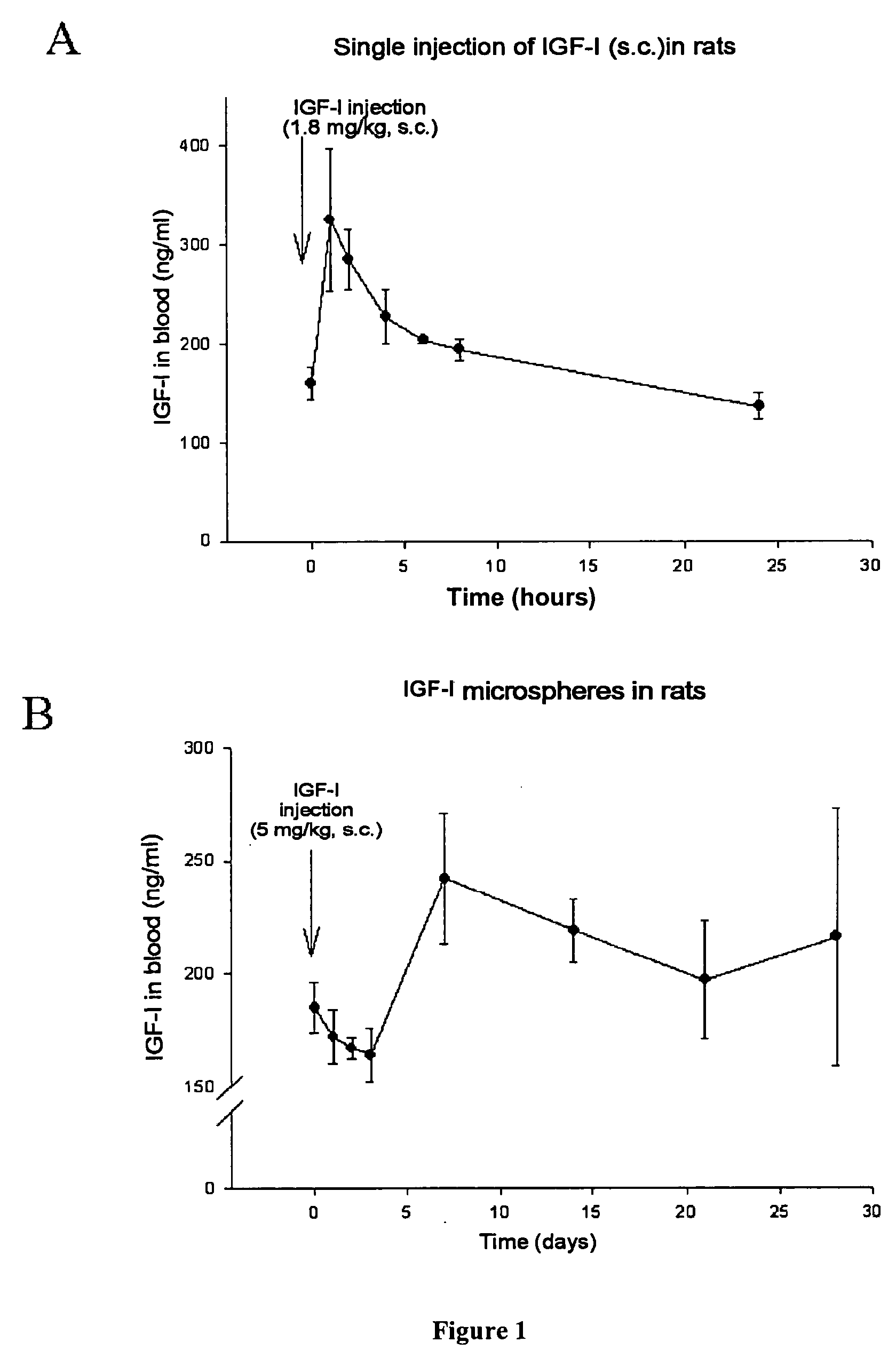Chemical ifg-i composition for the treatment and prevention of neurodgenerative diseases
a neurodegenerative disease and composition technology, applied in the direction of drug compositions, peptide/protein ingredients, metabolic disorders, etc., can solve the problems of reducing bioavailability and therapeutic efficacy, difficult to implant in humans, and no drug or method that protects against neurodegenerative diseases
- Summary
- Abstract
- Description
- Claims
- Application Information
AI Technical Summary
Benefits of technology
Problems solved by technology
Method used
Image
Examples
example 1
Elaboration and Administration of IGF-I Preparations
example 1a
Subcutaneous injection of IGF-I (FIG. 1A)
[0033] Lyophilised recombinant human IGF-I (rhIGF-I) (GroPep, Australia) is dissolved in saline solution (NaCl 0.9%) to obtain a concentration of 500 μg / 100 μl. Adult Wistar rats weighing 300 grams (n=6 for each collection time) receive a single subcutaneous injection (in scapula) of 100 μl. To evaluate IGF-I in serum by radioimmunoassay (I. Torres-Aleman, S. Pons, L. M. Garcia-Segura. Climbing fiber deafferentation reduces insulin-like growth factor I (IGF-I) content in cerebellum. Brain Res 564: 348-351 [1991]; S Pons and I Torres-Aleman Basic fibroblast growth factor modulates insulin-like growth factor-I, its receptor, and its binding proteins in hypothalamic cell cultures. Endocrinology 131: 2271-2278 [1992]), blood is collected after anaesthesia and sacrifice of animals at different times after IGF-I injection.
[0034] As described in FIG. 1A, a single subcutaneous injection of IGF-I (1.8 mg / kg) in adult rats caused a rapid increase in...
example 1b
Elaboration of IGF-I Microspheres
[0035] The preparation of IGF-I microspheres was carried out previously using a modification of the triple emulsion and A / O / A solvent extraction method described (Singh M, Shirley B, Bajwa K, Samara E, Hora M, and O'Hagan D (2001) Controlled release of recombinant insulin-like growth factor from a novel formulation of polylactide-co-glycolide microparticles. J. Control Release 70: 21-28), which allows the effective release of intact and biologically active IGF-I (Meinel L, Illi O E, Zapf J, Malfanti M, Peter M H, and Gander B (2001) Stabilizing insulin-like growth factor-I in poly(D,L-lactide-co-glycolide) microspheres. J. Control Release 70: 193-202; Singh M, Shirley B, Bajwa K, Samara E, Hora M, and O'Hagan D [2001]). The method begins with 40 mg of IGF-I dissolved in 100 microlitres of acetic acid 0.01 mM. To this dissolution is added 0.7 ml of monosodium phosphate 10 mM (pH 6.0) containing 10.5 mg of Tween 20 (Serva, Germany). At the same time,...
PUM
| Property | Measurement | Unit |
|---|---|---|
| diameter | aaaaa | aaaaa |
| diameter | aaaaa | aaaaa |
| diameter | aaaaa | aaaaa |
Abstract
Description
Claims
Application Information
 Login to View More
Login to View More - R&D
- Intellectual Property
- Life Sciences
- Materials
- Tech Scout
- Unparalleled Data Quality
- Higher Quality Content
- 60% Fewer Hallucinations
Browse by: Latest US Patents, China's latest patents, Technical Efficacy Thesaurus, Application Domain, Technology Topic, Popular Technical Reports.
© 2025 PatSnap. All rights reserved.Legal|Privacy policy|Modern Slavery Act Transparency Statement|Sitemap|About US| Contact US: help@patsnap.com


